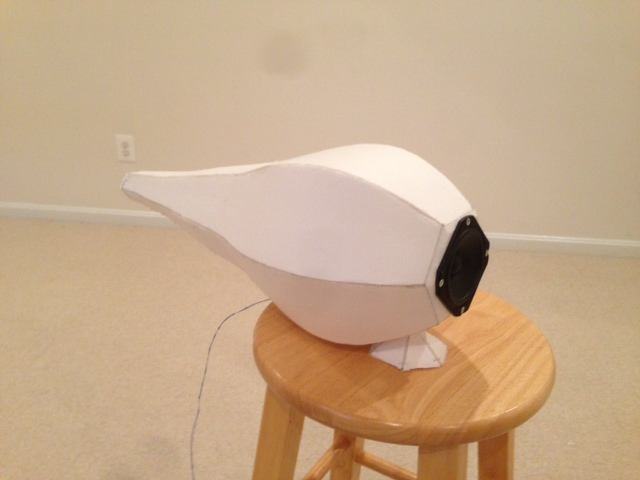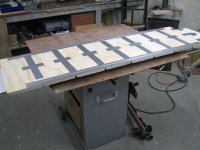I love the simple/clean look of these:Unmonday Model 4.3 Wireless Speaker | Unmonday
I am planning on building something similar around the HIVI B3S. I'm choosing the B3S because I've enjoyed years of listening to Zaph's enclosure. I've never really simulated an enclosure and just followed other peoples designs. The spec sheets suggest a 2L enclosure while I calculate Zaph's at 3.34L.
Under the design I can adjust the size of the baffle, depth, and back to get a desired volume. For example with a front hex edge of 4" and a rear hex edge of 2" and a depth of 7" I get a volume of roughly 3.34L (depicted in sketchup). I can also get roughly the same volume using 3.5", 2" and 9". Is there a suggested/golden ratio of front baffle to total volume for an enclosure?
Does anyone have experience building a similar shaped enclosure?
I appreciate any other suggestions/insights/considerations.
I am planning on building something similar around the HIVI B3S. I'm choosing the B3S because I've enjoyed years of listening to Zaph's enclosure. I've never really simulated an enclosure and just followed other peoples designs. The spec sheets suggest a 2L enclosure while I calculate Zaph's at 3.34L.
Under the design I can adjust the size of the baffle, depth, and back to get a desired volume. For example with a front hex edge of 4" and a rear hex edge of 2" and a depth of 7" I get a volume of roughly 3.34L (depicted in sketchup). I can also get roughly the same volume using 3.5", 2" and 9". Is there a suggested/golden ratio of front baffle to total volume for an enclosure?
Does anyone have experience building a similar shaped enclosure?
I appreciate any other suggestions/insights/considerations.
Attachments
I made a teardrop shaped speaker in a hexagon gore panel here.
http://www.diyaudio.com/forums/full-range/223313-foam-core-board-speaker-enclosures-208.html#post3739273
The extended shape avoids internal reflections so the sound is very uncolored.

http://www.diyaudio.com/forums/full-range/223313-foam-core-board-speaker-enclosures-208.html#post3739273
The extended shape avoids internal reflections so the sound is very uncolored.

Maybe a pentagon enclosure would be better? No parallel walls.
I must admit I have a hard time seeing the particular appeal this cabinet.
The HIVI B3S is hopeless if you're trying to do a battery powered speaker. It's SPL level is way too low and it won't get you anywhere near real bass without a sub.
It's definitely nowhere near a match for the A10 in the inspiration.
I must admit I have a hard time seeing the particular appeal this cabinet.
The HIVI B3S is hopeless if you're trying to do a battery powered speaker. It's SPL level is way too low and it won't get you anywhere near real bass without a sub.
It's definitely nowhere near a match for the A10 in the inspiration.
Is there a suggestion for an alternative driver? I'd like to keep as budget as possible for the first round. I like the pentagon idea, I'll try to pick up some foam core for prototyping.
The Vifa TC9FD is very nice sounding. Smooth response, low distortion, and only $12 ea. alternatives include Faital Pro 4FE35 at $25 ea - these are also very smooth and low distortion and get 91dB efficient.
Are octagons close enough? 😀 I built a pair of these octagonal pipes a long time ago. They are quite similar to Metronomes functionally.
If feasible, I suggest you put the driver on one of the long facets rather than the bottom. It really makes for outstanding imaging, as the diffraction is minimized.

If you prefer to make something more similar to that "Unmonday", why not just buy a hexagonal flower pot and start with that? It sure looks to me like that's what they did.
If feasible, I suggest you put the driver on one of the long facets rather than the bottom. It really makes for outstanding imaging, as the diffraction is minimized.
If you prefer to make something more similar to that "Unmonday", why not just buy a hexagonal flower pot and start with that? It sure looks to me like that's what they did.
FWIW, note that the very clever unmunday ( read the whole product description, including motion sensor for channel selection) uses Alpair 10.3. As distribution of this product is AFAIK still only Europe and the UK, there are likely few forum members who'll have heard them, but I'd imagine much of their performance could be attributed to the driver selection.
Xrk: did you cut the edges of the gourd shaped enclosures with any degree of bevel, or just butt joint, and glue from outside?
Xrk: did you cut the edges of the gourd shaped enclosures with any degree of bevel, or just butt joint, and glue from outside?
The FC is so thin that a bevel would not be needed and also the bevel would make it hard to apply a bead of hot melt glue to hold it all together. Interestingly this design looks small and compact compared to a box but has a lot of surface area and ended using I would say, 2x the number of foam core sheets a design of this size and volume has a right to. 🙂
Kerfed bendy plywood can work too and I would bevel that.
Kerfed bendy plywood can work too and I would bevel that.
I made a teardrop shaped speaker in a hexagon gore panel here.
http://www.diyaudio.com/forums/full-range/223313-foam-core-board-speaker-enclosures-208.html#post3739273
The extended shape avoids internal reflections so the sound is very uncolored.

What volume would you recommend for the TC9FD? I'm thinking of giving this a try with the driver mounted on one of the sides as Greg B suggested.
Thanks,
Mike
Mikej,
Are you looking at a sealed or vented alignment? Sealed, I would go with 3 to 5 liters. If mounting on sidewall make sure you go with odd number of panels to prevent flat-flat wall resonance. 5 or 7 sides works then. Good luck.
X
Are you looking at a sealed or vented alignment? Sealed, I would go with 3 to 5 liters. If mounting on sidewall make sure you go with odd number of panels to prevent flat-flat wall resonance. 5 or 7 sides works then. Good luck.
X
Mikej,
Are you looking at a sealed or vented alignment? Sealed, I would go with 3 to 5 liters. If mounting on sidewall make sure you go with odd number of panels to prevent flat-flat wall resonance. 5 or 7 sides works then. Good luck.
X
X,
Is this driver better in a sealed arrangement? If I do this, I'll probably pair it with a sub if need be.
Thanks,
Mike
I suppose the higher the n-gon, the less the parallel sidewall thing matters, especially considering a fully-stuffed sealed enclosure. If would be interesting to compare a perfect cube versus a more ideal on paper shape with no parallel walls and golden ratio sides or something, both sealed and stuffed to the same Vb/Fc/Qtc.
X,
Is this driver better in a sealed arrangement? If I do this, I'll probably pair it with a sub if need be.
Thanks,
Mike
If you have a sub that can cross at 150Hz to 200Hz then the TC9FD works best as a sealed. It should be high passed appropriately and will have very low distortion and higher power handling.
I suppose the higher the n-gon, the less the parallel sidewall thing matters, especially considering a fully-stuffed sealed enclosure. If would be interesting to compare a perfect cube versus a more ideal on paper shape with no parallel walls and golden ratio sides or something, both sealed and stuffed to the same Vb/Fc/Qtc.
It would seem there is a tendency for people new to DIY speakers to obsess on the parallel sidewall issue, and to go to great lengths making elaborate enclosures that avoid this 'issue'. I know I did. 😉 In practice, IME the parallel wall reflections aren't a very big deal. The interior of an enclosure is typically damped with damping materials to neutralize them. Frankly, a basic golden ratio rectangular box with 3 sides damped works as well as anything. That said, I recall building a spherical speaker once, and it was a total disaster. The coloration made it un-listenable. I'd guess a cube would not be quite as bad, but I'd still avoid it.
One thing I did learn: going to an "n-gon" makes for an extremely strong and rigid enclosure, even if quite thin material is used. I'd venture the improvements from reducing panel 'sing' are far more significant than a small reduction in residual standing waves bouncing around inside.
+1 on n-gons being stiff. The 6-sided gourd shaped speaker I made is very strong, stiff, and weighs nothing. Play around with paper panel templates made of newsprint. Glue it together to see how it looks then use template to cut foam core or wood with it.
It would seem there is a tendency for people new to DIY speakers to obsess on the parallel sidewall issue, and to go to great lengths making elaborate enclosures that avoid this 'issue'. I know I did. 😉 In practice, IME the parallel wall reflections aren't a very big deal. The interior of an enclosure is typically damped with damping materials to neutralize them. Frankly, a basic golden ratio rectangular box with 3 sides damped works as well as anything. That said, I recall building a spherical speaker once, and it was a total disaster. The coloration made it un-listenable. I'd guess a cube would not be quite as bad, but I'd still avoid it.
One thing I did learn: going to an "n-gon" makes for an extremely strong and rigid enclosure, even if quite thin material is used. I'd venture the improvements from reducing panel 'sing' are far more significant than a small reduction in residual standing waves bouncing around inside.
The sympathetic ringing of the cabinet panels is perhaps more important than the parallel walls issue. Cabinets with an uneven number of panels will have much less of this. The pentagon being a nice compromise between the inefficient triangle and the needlessly complex heptagon.
If nonparallel walls can make you use less stuffing though and get better efficiency that way, isn't that a good thing?
Echinoderm creatures like the starfish is using pentagon symmetry for some of the same reasons. Uneven polygons has no clear fault or break lines running through them.
- Status
- Not open for further replies.
- Home
- Loudspeakers
- Full Range
- Hexagon Enclosure?




